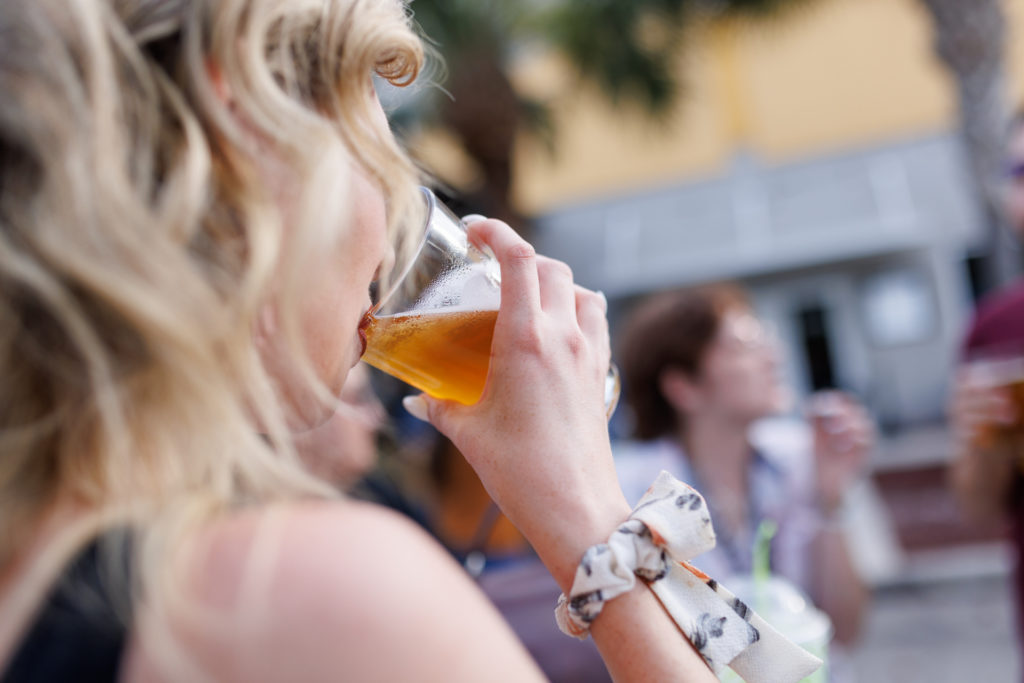The day Fort Myers Brewing Co. opened in February 2013, owners Jen Gratz-Whyte and Rob Whyte walked through the city’s Gateway neighborhood, putting up yard signs for their new brewery. “We were talking about how many people we thought would show up, and I said, ‘If we get 50 people, it would be a great success; 10 would be cool,’” Jen recalls. “We’re putting up signs, and all of a sudden, there’s this caravan of cars following us.” Not long after the noon opening, a line snaked out the double doors of the 400-square-foot taproom, wrapping around the building in an otherwise quiet industrial park. Within six hours, they’d kicked every keg in the house.
At the time, Fort Myers Brewing was the first brewery in Lee County. Collier had only one: Naples Beach Brewery had opened just a few months earlier. “We couldn’t believe no one had done this yet,” Jen says. Nine years later, our region has nearly two dozen breweries. Fort Myers Brewing—now the fifth-largest taproom in the state by volume—has ballooned to 4,000 square feet (plus another 18,000 square feet for production), with its beers sold in more than 1,000 restaurants, bars and bottle shops in the area.
“People like supporting local. They like knowing the people making their products.” –Jen Gratz-whyte, Fort Myers Brewing
On an end-of-season Friday, a bartender with a handlebar mustache pours samples of strawberry-rhubarb gose, peanut butter porter and the bestselling High 5 IPA from a wall of taps draped with brewing competition medals. Small parties are scattered throughout the room, spilling out of the warehouse’s rolled-up garage doors into the beer garden, where leashed pups nap lazily around their owners’ ankles. Nevermind Awesome Bar & Eatery’s food truck is slinging Bitchin’ Bacon Burgers in the parking lot. Later tonight, there will be a live local band; other days of the week, there’s a regular roster of beer brunches, food truck rallies, festivals and more. “People like supporting local. They like knowing the people making their products,” Jen says. “But it’s also the community feeling.”
Fort Myers Brewing may be our largest brewery, but it’s by no means unique in the spirit it engenders. On any given evening, groups play cornhole, pints in hand, under the slatted pergola at Ankrolab Brewing Company in Naples’ Bayshore Arts District; beer nerds pair esoteric Düsseldorf Altbier and Czech pivo with housemade pulled pork tacos at Eight-Foot Brewing in Cape Coral; and millennials with ’90s nostalgia pack the house for emo night at basement-chic Ceremony Brewing in Bonita Springs, sipping fruited ambrosia sours and porters made with locally roasted Grumpy Goat Coffee.
“We refer to it as a third space,” says Ana Rodriguez de Vera, who opened Bonita Springs’ Hopsized Brewing Co. with her husband, Darlyn Victor, in November. “Hopsized is where you leave whatever nonsense is going on at the door. You come in, hang out and unwind.” Coined by urban sociologist Ray Oldenburg in his 1989 book, The Great Good Place, ‘third places’ are social gathering spaces away from home (the first place) and work (the second place) that anchor a community’s social, creative and civic interactions. Breweries are natural fits, as taprooms are often adaptable and inclusive. In the same month, Riptide Brewing Company’s locations in the Naples Design District and Bonita Springs could host a meeting of the Southwest Florida chapter of the American Institute of Architects, drag bingo and trivia night, while Ankrolab might have a slate of niche events, like a Sip & Script Modern Calligraphy class. Yoga, trivia nights and sets by local musicians are all standard fare—and increasingly, so are family-friendly options. Riptide had nine mini-golf holes at its Bonita Springs location until recent Florida weather damaged the setup, and Millennial Brewing opened Thirsty AF, a bar serving nonalcoholic, plant-based kava, kratom and kid-friendly drinks, inside its taproom to appeal to teens and young families.

Breweries also tap into the local-first ethos that popularized farm-to-table dining—but with a more approachable price tag. “People with [collaborative] mentalities are being drawn to the brewing industry,” says Kim West of Riptide. “Those are the first people to look for inclusive spaces.” For those who ultimately open breweries, the trajectory seems to follow a predictable pattern: Get into craft beer, start homebrewing, share your experiments with friends, enter a few competitions, win some medals and then start looking for a space to build out your dream neighborhood bar.
For Millennial Brewing Company, that space was a former carpet storage warehouse in downtown Fort Myers in 2016. Owner Kyle Cebull spent six months stripping the building down to the studs, transforming the abandoned space into a community hub that now hosts monthly street fairs that draw thousands of people; frequently, 10 percent of the proceeds go to local causes like Valerie’s House, Blessings in a Backpack and Lee County Schools. “The idea from the beginning was a mutual benefit to the city and us,” Kyle says. “In a very ethical, community-minded way, we’d take a dilapidated, unused sector and turn it into a busy area that people are frequenting.”
Crazy Dingo Brewing Co. owners Dan Esperon, Mike Schwab and Stu Paasche chose to set up shop in shipping containers on Southern Fresh Farms in Fort Myers. The trio had been brewing out of Stu’s garage, using fruit from neighbors’ trees to flavor their mango hefeweizen and banana-Nutella milk stout. “We were approached about opening in a strip mall, but we wanted to be on a farm and have an aspect that throws a wrench in the system,” Dan says. “It’s not only craft beer; it’s also craft farming. We’re trying to build a full-circle process.” That includes growing hops. The flowering vines typically thrive in cold-weather conditions, but Crazy Dingo is experimenting with the Cascade variety (which better tolerates Florida’s muggy climate) to make truly Southwest Florida-hopped brews.
On the other end of the spectrum, Ceremony’s Zach Smith feels strongly about being in downtown Bonita, where he hopes his brewery and bottle shop, along with other new businesses like Hopsized and fine-dining restaurant The Bohemian, will foster a walkable entertainment district. “I’m always impressed to see the vast majority of people coming from the immediate vicinity,” he says of his customers. Tucked down a side street, the brewery’s design breaks with the beachy and industrial vibes popular in the area, opting instead for matte black walls, comfy leather couches and a playlist that leans into punk rock and metal. “If I was going to give up my career, I wanted a place that represented me, where I would be comfortable spending 85 hours a week,” says Zach, who worked in hospitality management and as an elementary school teacher for Collier County Public Schools before opening Ceremony last fall. “I thought for sure I’d be fending off complaints about the music we play, but it’s been our number one compliment. If you’re authentic, people will gravitate toward that.”

For brewers, self-expression also extends to what’s in the glass. There’s no one style that seems to define the region—although beers with a refreshing, ready-for-the-beach character always sell well. Hopsized focuses on hazy, juice-bomb New England IPAs; Crazy Dingo excels at fruity ales; and Point Ybel Brewing Company’s Jordan Weisberg is passionate about the nuances of crisp, easy-drinking German lagers. “It’s an art form,” Zach says. “You get to express yourself, your palate and your interests.” In the first eight months of operation at Ceremony, he and head brewer Ryan Carruth (a Fort Myers Brewing alum) rotated more than 50 different beers through their taps, including the Cosmic Ghost peach saison, Tropic Rot mango milkshake IPA and Vanish Into Darkness, a chocolate-coconut stout. “We don’t want to be a slave to any given recipe,” Zach says. “When you have flagships and core beers, there’s an expectation that those are always on. We’re constantly inspired to try new things.”
Cape Coral’s Eight-Foot Brewing specializes in historical styles and barrel-aged brews, like the Henrietta, a tart, vanilla-scented amber sour fermented in bourbon barrels. The complex beer is as close as owner Roger Phelps gets to a flagship, but the barrel fermentation process is less consistent than steel-tank brews: “We repeat the process, but the fun thing is it ferments in the barrel, and those microbes are going to be different.” Behind the bar, he doesn’t shy away from delving into the specifics of microbes and 19th-century brewing recipes with customers. “Ninety-five percent of the beer we make is served in-house,” he says. “When you walk in, we encourage you to ask questions.”
Unsurprisingly for an industry that thrives on building community ties, brewers are teaming up on special beers. Ankrolab dropped a hoppy West Coast IPA with Hopsized for its third anniversary in April. Hopsized also partnered with all-women-owned Equity Brewing Company in Oklahoma on a hazy pale ale and a New England IPA. Ceremony brewed an oak-aged saison with Chartreuse Craft Cocktail Lounge, another Bonita newbie. And Fort Myers Brewing created a cinnamon-vanilla stout with Palm City Brewing Co. for the inaugural SWFL Craft Beer Week last fall (and returns for another year, Sept. 1-5, 2022).

The generosity spills out into the community, too, with breweries stepping up for area nonprofits. At Millennial, Kyle estimates he’s donated $500,000 to more than 200 nonprofits in direct contributions, goods, services and access to the brewery’s cavernous event spaces since 2016. In May, Riptide released the latest iteration of Athena Ale, named for the Naples Zoo at Caribbean Gardens’ beloved Florida panther—a partnership that goes back seven years and has helped to fund wildlife cameras and cleanup of paths under highways where panthers have been documented. Fort Myers Brewing partnered with Captains For Clean Water over the summer on Send It South Pale Ale to benefit the nonprofit’s mission to restore and protect local waters. And proceeds from special-release beers at Ankrolab have benefited The Alliance for Florida’s National Parks, Audubon of the Western Everglades and Friends of Rookery Bay. (The brewery also donates its spent grain to Naples Botanical Garden for compost. In exchange, when the Garden has a bumper crop, Ankrolab turns it into small-batch chocolate-ginger stout, lychee rice lager and mango ale.)
As the scope of giving grows, so do the breweries themselves. Fort Myers Brewing is building a new 7,900-square-foot taproom with a festival-worthy patio and an acre of grassy lawn for kids to run and play. Hopsized is expanding into the space next door with plans for a new, date night-worthy concept (no kids allowed). Ceremony is working with the city to develop the surrounding property, with plans to add landscaping, an outdoor bar, onsite eateries and a stage for live performance. Riptide eyes an expansion up the coast, with each taproom serving as a hyper-localized reflection of the community where it’s pouring its ice-cold beers. “I see unlimited growth. From a creative flow, I wouldn’t even try to guess how many different things brewery culture could encompass in the next five years,” Kim says. “My philosophy has always been if 10 new breweries opened tomorrow, it would be an amazing thing. More collaboration lifts the whole community up.”



